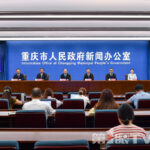By 2027, Chongqing will renovate 1,800 old residential communities, 150 urban villages, and 29,400 dilapidated housing units. It will upgrade 10,000 old elevators and create 100 modern communities. The city will optimize and upgrade over 25 historical streets and cultural tourism leisure districts, while preserving and restoring 23 nationally recognized historical and cultural towns, 13 historical and cultural blocks, and 20 municipal-level industrial heritage sites.
These goals were announced during a press conference focused on building a high-quality modern city for the people and improving urban livability and functionality.
Efforts will focus on balancing point-specific and area-wide improvements, hardware and software upgrades, physical form and cultural essence, as well as enhancing both urban and industrial capacity—ensuring residents see tangible benefits from urban renewal.
Specifically, Chongqing will work to create high-quality urban living environments, systematically developing better housing, neighborhoods, communities, and districts—shifting the focus from constructing buildings to building homes and lifestyles.
On a micro level, the city will meticulously renovate dangerous old housing, aging residential areas, and urban villages, addressing service shortfalls for both the elderly and children—such as community canteens and childcare—while improving parking, EV charging, waste sorting, and other community facilities to establish a “15-minute high-quality living service circle.” On a macro level, urban renewal will expand from individual communities to blocks and entire districts, with plans to develop over 30 demonstration zones for urban renewal, making the city more comfortable, vibrant, and distinctive.
Additionally, Chongqing will strengthen its modern urban infrastructure system. By 2027, the city aims to expand rail transit mileage to 750 kilometers, increasing the share of public transit trips via rail to 70%. It will improve the integrated transit network combining rail, bus, and pedestrian pathways to make commutes faster and more pleasant.
Furthermore, the city will enhance architectural and urban design management. Emphasis will be placed on preserving external style and internal cultural spirit, holistically improving urban form, business ecology, cultural ambience, and living experience to avoid generic cityscapes. The approach prioritizes preservation, renovation, redevelopment, and addition—with “preservation” as the top priority—allowing the city to grow organically while retaining collective memory.
Urban renewal will also help boost both urban and industrial capacity. In the future, Chongqing will fully assess and repurpose underutilized spaces through social investment, creating new lifestyle, consumption, and entrepreneurship settings popular with young people and generating more local employment and income opportunities.
historical streets
The term “historical streets” refers to preserved urban pathways, such as the cobblestoned lanes of Europe’s old towns or the ancient routes of cities like Jerusalem and Rome, which have been in continuous use for centuries. These streets often originated as vital trade routes, pilgrimage paths, or the central arteries of a growing settlement. They serve as living museums, with their architecture and layout offering a direct, tangible connection to the daily life of past eras.
cultural tourism leisure districts
Cultural tourism leisure districts are revitalized urban zones that blend historic preservation with modern entertainment, often repurposing former industrial or commercial areas. They typically feature museums, performance venues, restaurants, and public art, creating a pedestrian-friendly environment for both tourists and locals. Their history is rooted in late 20th-century urban renewal movements that sought to attract visitors by transforming underused historic infrastructure into vibrant cultural hubs.
historical and cultural towns
Historical and cultural towns are settlements officially recognized for their preserved architecture, urban layout, and intangible heritage, often dating back centuries or even millennia. Their history is typically rooted in specific periods of economic prosperity, such as being former trading posts, administrative centers, or hubs of artisan crafts. These towns serve as living museums, safeguarding traditional customs, festivals, and a unique local identity for future generations.
historical and cultural blocks
Historical and cultural blocks are preserved urban districts, often pedestrianized, that showcase a city’s architectural heritage and traditional way of life. They typically consist of old streets, shops, and residences that have been restored to reflect a specific historical period. These areas serve as living museums, protecting local history and customs while functioning as popular centers for commerce and tourism.
industrial heritage sites
Industrial heritage sites are preserved remnants of industrial society, including factories, mines, and transport infrastructure, that hold historical and cultural significance. They emerged from the 20th-century preservation movement seeking to protect the physical evidence of the Industrial Revolution and its profound social and technological changes. Today, these sites are often repurposed as museums, cultural centers, or public parks, serving as monuments to our industrial past.
15-minute high-quality living service circle
The “15-minute high-quality living service circle” is a modern urban planning concept, not a historical site. It is a policy model, pioneered in cities like Paris and now adopted in China, that aims to ensure all residents can meet their daily needs within a 15-minute walk or bike ride from their home. The goal is to create more sustainable, healthy, and equitable communities by decentralizing essential services like groceries, healthcare, and green spaces.
demonstration zones for urban renewal
Demonstration zones for urban renewal are designated urban areas, often in China, that serve as pilot projects for testing and showcasing new approaches to modernizing aging city districts. Their history is rooted in recent government-led initiatives to address urban decay, improve living standards, and promote sustainable development through innovative planning and smart city technologies. These zones function as living laboratories to model successful redevelopment strategies before they are implemented on a wider scale.
integrated transit network
An integrated transit network is a modern urban planning concept that seamlessly connects different transportation modes (buses, trains, subways, bicycles, etc.) into a single, coordinated system. Its history is rooted in the 20th and 21st centuries, evolving from disjointed services to address growing congestion and environmental concerns in cities. The goal is to provide efficient, user-friendly mobility by allowing easy transfers and unified ticketing across all forms of public transit.


